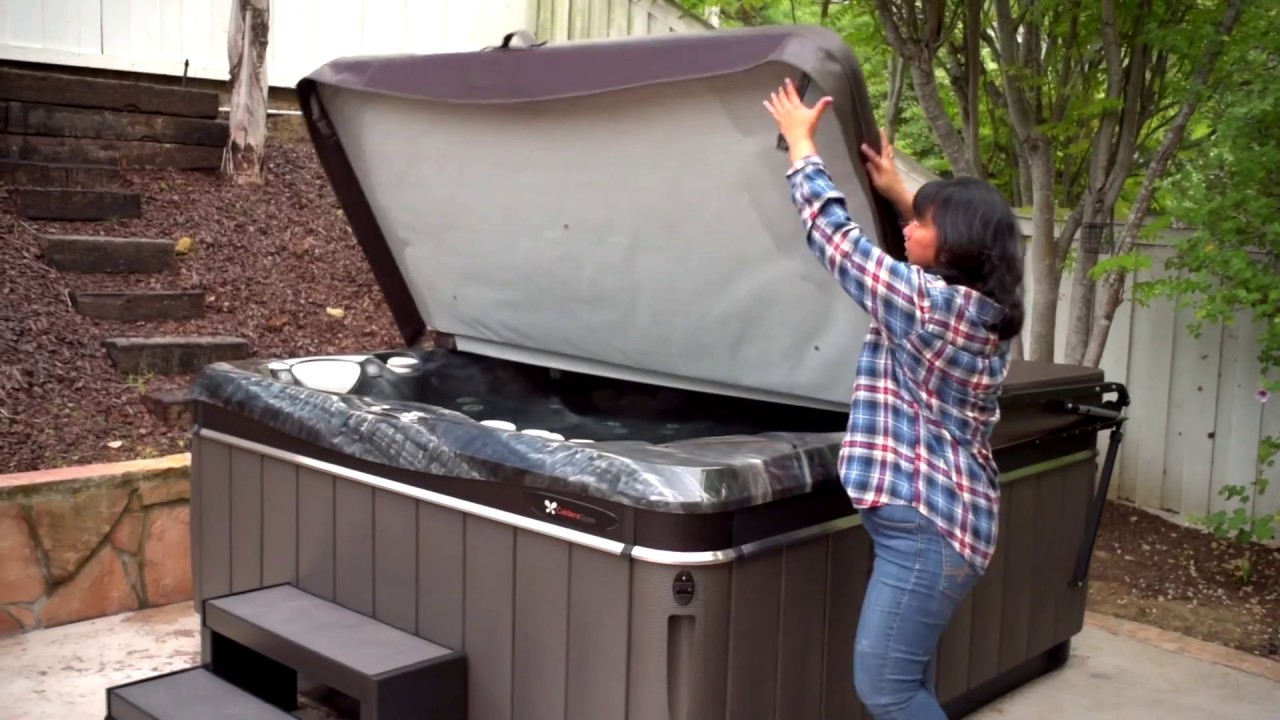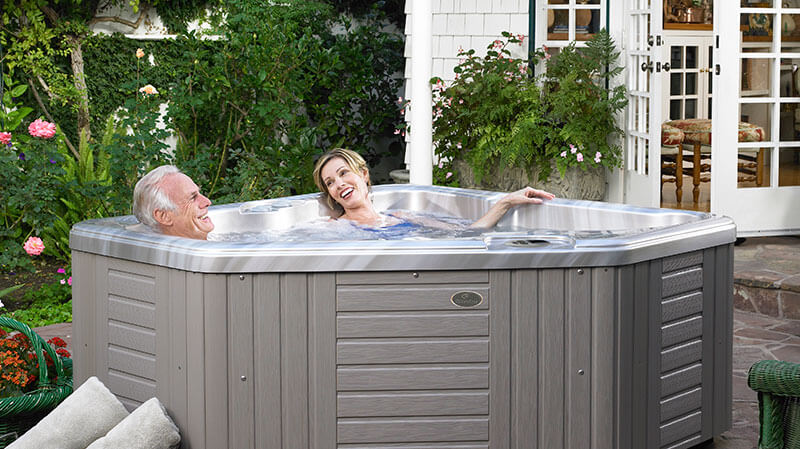
October arrives in Delaware with a spectacular display of changing leaves, crisp morning air, and the first hints of coastal autumn storms. While the season brings beautiful scenery, it also introduces unique challenges for hot tub owners throughout the Lewes and Millsboro areas.
Fall hot tub maintenance Delaware residents need goes far beyond simply sweeping leaves off their covers. From managing water chemistry affected by organic debris to protecting equipment from increased moisture, comprehensive autumn spa care requires attention to your entire system.
Delaware’s coastal location adds another layer of complexity during fall months. Salt air, wind-blown sand, coastal storms, and the inevitable invasion of acorns and pine needles all impact how you maintain your Hot Spring® or Caldera Spas® investment. This guide addresses the multiple seasonal challenges that autumn brings, helping you protect your spa while continuing to enjoy it throughout the cooler months ahead.
Managing Leaf Debris and Coastal Autumn Elements
The most visible autumn challenge involves protecting hot tubs from leaves Delaware’s abundant trees produce during October and November. However, the real concern extends beyond aesthetics. When leaves, acorns, pine needles, and other organic matter make their way into your spa water, they begin decomposing immediately. This decomposition process doesn’t just cloud your water—it fundamentally alters your water chemistry.
How Organic Debris Affects Your Water Chemistry
Organic debris introduces tannins and other compounds that can lower pH levels and increase your water’s acid demand. According to the Centers for Disease Control and Prevention, maintaining proper pH between 7.2 and 7.8 is essential for sanitizer effectiveness and preventing equipment corrosion.
When leaves decompose in your spa, they consume available sanitizer, creating an environment where bacteria and algae can flourish. Even a single day of heavy leaf accumulation can significantly impact your chlorine or bromine levels.
Delaware’s Unique Coastal Challenges
For Delaware coastal residents, autumn debris management involves more than traditional fall foliage. Salt spray from nor’easters, wind-blown sand, and the prolific acorn drops from the region’s oak trees all require attention. Pine needles present a particular challenge because their small size allows them to slip past covers and into filtration systems, where they can clog components and reduce water flow efficiency.
Practical Protection Strategies
Effective autumn spa care tips start with daily visual inspections of your cover. Remove leaves, acorns, and debris each morning before they have time to stain your cover or work their way underneath.
For coastal installations, consider positioning windbreaks—such as privacy screens or strategic landscaping—to reduce the amount of debris that reaches your spa during autumn storms. A leaf net placed over your regular cover during peak fall months provides an additional protective layer that’s easy to remove and clean.
The area surrounding your hot tub deserves equal attention. Debris that accumulates on decking inevitably finds its way into your water when you enter and exit the spa. Keep the three-foot radius around your hot tub clear of leaves and organic matter.
Water Chemistry Adjustments for Fall Conditions
Delaware’s autumn weather patterns create unique water chemistry challenges that differ significantly from summer hot tub water care issues.
Increased rainfall during October and November introduces fresh water into your spa—even when covered—through condensation and moisture that collects on covers and eventually drips into the water when opened. This dilution effect reduces sanitizer concentration and can alter your carefully balanced pH and alkalinity levels.
Increased Testing Frequency is Essential
The organic matter that inevitably enters your water during fall increases your spa’s oxidizer demand. When debris decomposes, it consumes available sanitizer, meaning you’ll need to test and adjust your water chemistry more frequently than during other seasons. While summer maintenance might require testing twice weekly, autumn conditions often necessitate testing every other day during peak leaf-fall periods.
Temperature Effects on Chemical Performance
Temperature fluctuations also affect chemical behavior in your spa water. As overnight temperatures drop into the 40s and 50s throughout Delaware, chemical reactions slow down. Sanitizers dissolve more slowly in cooler water, and pH adjusting chemicals take longer to incorporate fully.
This means timing becomes important—add chemicals during the warmer afternoon hours when possible, allowing them adequate time to dissolve and circulate before evening temperatures drop.
Delaware’s coastal humidity continues through autumn, though at lower levels than summer. This ongoing moisture affects water evaporation rates and can concentrate minerals in your spa over time. Regular water testing helps you monitor total dissolved solids and determine when partial water changes become necessary. Most spa manufacturers recommend partial water replacement every three to four months, making autumn an ideal time for this maintenance task before winter arrives.
Filtration and Equipment Adjustments for Fall
Your spa’s filtration system works harder during autumn months as it processes increased debris, organic matter, and particulates introduced by seasonal conditions. Adjusting your filtration schedule helps maintain water clarity and reduces strain on your equipment.
Most Hot Spring® and Caldera Spas® models allow you to program filtration cycles; consider increasing your daily filtration time by one to two hours during October and November.
Critical Fall Equipment Maintenance Tasks:
- Clean filters more frequently: While you might clean your filter monthly during low-use periods, autumn conditions often require bi-weekly or even weekly cleaning. A dirty filter reduces water flow through your heating and sanitation systems, forcing your equipment to work harder and potentially shortening its lifespan. Regular filter maintenance is one of the most effective ways to extend hot tub equipment longevity.
- Check skimmer baskets and drains daily: Pay particular attention to these components during heavy leaf periods, removing any debris before it can be drawn into your filtration system. Acorns and pine needles can bypass these initial barriers if they accumulate, potentially reaching your pump and causing damage to impellers or seals.
- Inspect seals and gaskets before winter: Autumn provides an ideal window for examining all access panel seals, pump unions, heater connections, and plumbing joints. Small leaks that seem insignificant during warm weather can become serious problems when temperatures drop. Addressing these issues during fall prevents emergency repairs during winter months.
- Protect electronics from moisture: Delaware’s coastal environment means your spa equipment faces exposure to salt air year-round, but autumn storms can increase this exposure. Electronic components, control panels, and circuit boards are particularly vulnerable to moisture and corrosion. Ensure all equipment compartment covers seal properly and consider applying dielectric grease to electrical connections as preventive maintenance against autumn humidity.
Preparing for the Transition to Winter
Autumn serves as your preparation window between summer’s easy maintenance and winter’s more demanding conditions. The proactive work you complete during October and November determines how smoothly your spa operates during Delaware’s coldest months.
This preparation period allows you to address minor issues before they evolve into problems that could interrupt your winter hot tubbing enjoyment.
Why Fall Preparation Matters:
- Identify leaks before freezing temperatures: A minor plumbing drip that wastes water during fall becomes a potential freeze hazard when temperatures drop below 32°F.
- Address cover wear now: Worn cover latches or torn cover material that seems manageable during mild weather allows heat loss during winter that significantly increases your energy costs.
- Test heating efficiency: Delaware’s autumn weather provides ideal conditions for testing your spa’s heating efficiency. As overnight temperatures cool, monitor how quickly your spa recovers to set temperature after use. Sluggish heating might indicate scale buildup on heating elements, requiring professional cleaning.
- Schedule professional maintenance: For Delaware Hot Tubs customers in the Lewes and Millsboro areas, autumn is an excellent time to schedule professional maintenance if you haven’t done so recently. Technicians can inspect components that aren’t easily accessible to spa owners, including internal plumbing, pump seals, heating elements, and control system diagnostics.
Hot Spring® and Caldera Spas® both incorporate advanced insulation systems designed for year-round use, but autumn testing helps ensure these systems are functioning optimally before winter demands peak performance.
The essential August tasks you completed to prepare for fall sets the foundation for autumn maintenance. Now, as November approaches, your focus shifts toward winter readiness while still enjoying your spa during autumn’s beautiful weather. Delaware’s moderate climate allows year-round hot tub use, making proper maintenance more important than in climates where spas are winterized and drained.
Protecting Your Investment Through Comprehensive Fall Care
Fall hot tub maintenance Delaware owners implement protects far more than just equipment—it safeguards your investment, ensures consistent water quality, and maintains the therapeutic benefits that make spa ownership worthwhile.
The multi-faceted approach to autumn spa care addresses challenges that other seasons don’t present: managing unprecedented organic debris, adapting water chemistry for increased rainfall, adjusting equipment operation for cooler temperatures, and protecting surrounding structures from wet weather.
Delaware’s unique coastal environment means hot tub owners face autumn challenges that differ from inland or northern climates. The combination of salt air, coastal storms, abundant trees producing leaves and acorns, and the region’s specific precipitation patterns all influence how you should maintain your Hot Spring® or Caldera Spas® system.
By addressing each of these elements systematically throughout October and November, you ensure your spa remains ready for enjoyable winter use while preventing problems that could lead to costly repairs.
The Reward of Proactive Fall Maintenance
The effort invested in comprehensive fall maintenance yields rewards throughout winter and beyond. Protecting hot tubs from Delaware’s tree drop is just the starting point. When you also adjust water chemistry for seasonal conditions, increase filtration during high-debris periods, protect equipment from moisture, and maintain surrounding decking, you create a complete care program that extends your spa’s lifespan and maintains optimal performance.
As autumn progresses in Delaware, remember that each maintenance task serves a specific purpose in your overall spa care strategy. The time spent clearing debris, testing water, cleaning filters, and protecting your investment pays dividends in consistent performance, lower operating costs, and uninterrupted enjoyment throughout the year.
If you have questions about autumn maintenance specific to your Hot Spring® or Caldera Spas® model, the experienced team at Delaware Hot Tubs is available to provide guidance and professional service at our Lewes and Millsboro showrooms.




